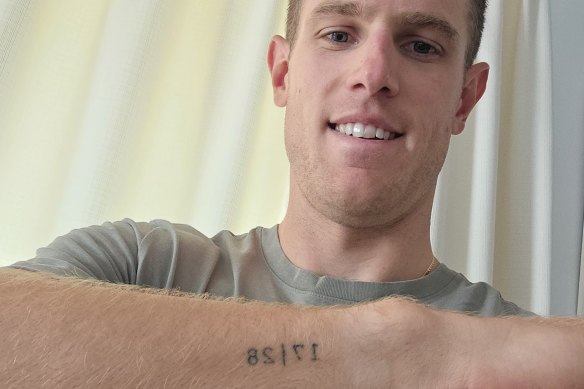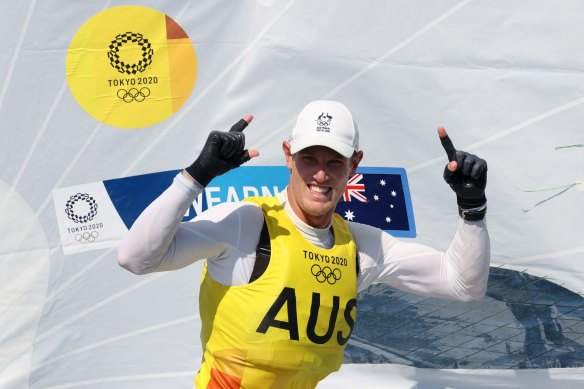Matt Wearn won an Olympic gold medal and in the days afterwards found himself at a tattoo parlour. A big deal? Hardly.
Wouldn’t it be easier, instead of handing out a bouquet to those on top of the podium after conquering their chosen sport, to slip a note with directions to the closest ink venue instead? That seems a more natural rite of passage.

Australia’s Tokyo Olympic Games gold medallist Matt Wearn with a commemorative tattoo of his finishing positions in his first two races before his comeback win.
“I wasn’t really a fan of the whole tattoo thing and I thought getting the [Olympic] rings in general was a bit of a gimmick,” Australia’s champion sailor Wearn says.
So, now he has four numbers on the outside of his right forearm. One is 17, the other 28. It would be easy to assume they have some sentimental value to him or his family, but they don’t. They just signify when he was sailing badly.
They were Wearn’s finishing positions in his first two races of the Tokyo Games. After that, the pre-regatta favourite surged back to win gold. It was Australia’s third straight Olympic Games win in the men’s Laser class.
“I very vividly remember talking to ‘Blackers’ [Michael Blackburn], my coach at the time, and saying, ‘why is it going this way? This isn’t how my Games experience is meant to be and why is this happening?’
“Now [the tattoo] sits just next to my watch. If you have a tough day’s sailing and you have a shower, look in the mirror and see your reflection, it’s a reminder no matter how tough today was, you can turn it around tomorrow.”

Matt Wearn of Team Australia celebrates winning gold in Tokyo.Credit: Getty Images
For any Olympic gold medallist, there can be a range of emotions in the months afterwards: elation, fulfillment, contentment, ambition, even depression that it’s over.
But for Wearn, his post-gold experience involved countless days in bed and on the couch, looking at the four numbers, wondering if his body would allow him to sail properly again. He not only fell sick but was so sick he couldn’t seem to shake it. It was eventually diagnosed as long COVID.
For most of the first year after he won Olympic gold, Wearn struggled to get out of bed or off the couch. He tried to sail a few times, and couldn’t figure out why his body felt so horrible. His mind stayed relatively sharp, but he needed to rest. It was a struggle walking down to the local shops. Every time he looked down, 17 and 28 were there to remind him when times were difficult.
“Those early days were very tough and the acceptance of what it was and the recovery that was needed,” Wearn said. “The idea is to show, ‘you’re not the only one really struggling with this’.
“The expectation, definitely for the following year, was riding high and enjoying the fruits of being an Olympic gold medallist, enjoying that confidence and racing with that confidence. In some sense, that was taken away from me from a health point of view. That was quite hard to deal with.”
But he found peace with a physiologist, who established a support group for other elite athletes afflicted with long COVID. Wearn started talking to others and while being forced to miss the 2022 world championships, planned his wedding to fellow Olympian, Belgium’s Emma Plasschaert, as he recovered (they didn’t see each other for six months leading to Tokyo 2020 due to COVID bubbles). They wed early last year.
Since then, Wearn has returned to his best, winning his first and second world titles and is now basing himself in Marseille for his Olympic defence. He still has hay fever relief and decongestant at hand for when his symptoms flare up, but he’s back on the water and trying to keep Australia’s proud history of men’s Laser success alive following the victories of Tom Slingsby (London) and Tom Burton (Rio).
“I’m one of the lucky people back doing what I do,” he says. “Now I feel fitter and stronger than I ever have in my career. People expect us to bring home gold medals now. Now, we’ve done it three times in a row with three different sailors is really special. To continue that and bring home a fourth would be really special.
“I still deal with stuff on a daily basis from a long COVID point of view. But it’s about understanding the stuff I’m going through is nothing compared to what other people are experiencing.”
For the record, Plasschaert twisted Wearn’s arm to also get a “gimmick” tattoo. He has the Olympic rings permanently etched on his body.
But the “17 and 28” is the one he admires most.
“I don’t mind the tattoo thing now and with the numbers on my arm, it will really be with me forever,” he says.
Sports news, results and expert commentary. Sign up for our Sport newsletter.